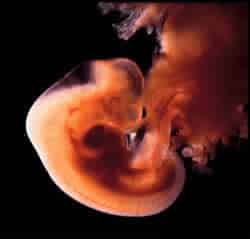
According to the findings published in the journal PLOS ONE, women who had two or more miscarriages were found to have very high level of a molecule in the womb cell called IL-33. This protein affects whether an embryo is accepted by the womb or not.
They found that women who had suffered multiple miscarriages continued to secrete it for an extra ten days.
The researchers also believe that now that the role of this molecule is known, in the future a drug could be developed that could prevent the action of IL-33 and help those women conceive who are more vulnerable to miscarriage.
Dr Madhuri Salker, of Imperial College London, told the Daily Mail,
‘Our study suggests in women who have had successive miscarriages, the mechanisms that control whether the womb can accept and support an embryo don’t work properly. This might mean they can become pregnant with poor quality embryos or the embryo implants in an unsupportive environment, which would seriously compromise the chances of a successful pregnancy.’
The researchers studied the affect of the molecule in mice fertility. When uteruses of mice were treated with chemicals secreted by cells from the human womb lining, they found that this chemical extended the time during which mice could become pregnant, and also made miscarriages more likely.
The scientists say that because the window of fertility increases, it also increases the chance of an abnormal embryo getting planted on the womb. In addition the molecule causes inflammation in the lining of the womb compromising the development of healthy embryos.
Study co-author Professor Jan Brosens, of the University of Warwick, said,
‘The molecular signals we identified are known to be involved in a range of diseases including Alzheimer’s, asthma and heart disease. Our findings suggest targeting these molecules might also be a promising strategy for developing treatments that would prevent miscarriages in women who are especially vulnerable.’
For a woman to conceive the embryo must implant itself on the womb wall which is receptive for only a few days during the menstrual cycle. Currently it is still not clearly known what are the processes that control this fragile time limit for implantation but the discovery of IL-33 shows some aspects. It influences the activity of the nearby cells and normally its affect is short lived. But in women more vulnerable to miscarriage, its affect is for a longer time.






